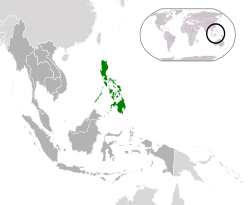Fifth Philippine Republic
|
Republic of the Philippines
Republika ng Pilipinas (Tagalog)
|
|||||
|---|---|---|---|---|---|
|
|||||
|
Motto: "Maka-Diyos, Maka-Tao, Makakalikasan at Makabansa"
("For God, People, Nature, and Country") |
|||||

Location of the Philippines – green
in ASEAN – gray |
|||||
| Capital |
Manila 14°35′N 120°58′E / 14.583°N 120.967°E |
||||
| Official languages |
Filipino English |
||||
| Government | Presidential republic | ||||
| Rodrigo Duterte | |||||
| Maria Leonor Robredo | |||||
| Legislature | Congress of the Philippines | ||||
| Senate | |||||
| House of Representatives | |||||
| Establishment | |||||
| February 2, 1987 (30 years ago) | |||||
| Currency | Peso (Filipino: piso) (₱) (PHP) | ||||
| ISO 3166 code | PH | ||||
This article covers the history of the Philippines following the 1986 People Power Revolution known as the contemporary history of the Philippines.
With the People Power Revolution, Corazon Aquino's assumption into power marked the restoration of democracy in the country. Aquino immediately formed a revolutionary government to normalize the situation, and provided for a transitional "Freedom Constitution" that restored civil liberties and dismantled the heavily Marcos-ingrained bureaucracy— abolishing the Batasang Pambansa and relieving all public officials. The Aquino administration likewise appointed a constitutional commission that submitted a new permanent constitution that was ratified and enacted in February 1987. The constitution crippled presidential power to declare martial law, proposed the creation of autonomous regions in the Cordilleras and Muslim Mindanao, and restored the presidential form of government and the bicameral Congress.
Progress was made in revitalizing democratic institutions and respect for civil liberties, but Aquino's administration was also viewed as weak and fractious, and a return to full political stability and economic development was hampered by several attempted coups staged by disaffected members of the Philippine military. Aquino privatized many of the utilities the government owned, such as water and electricity. This practice was viewed by many as Aquino catering to oligarchic as well U.S. interests, losing the government's power of regulation.
Economic growth was additionally hampered by a series of natural disasters. In June 1991, Mount Pinatubo in Central Luzon erupted, after being dormant for 600 years. It was the 2nd largest volcanic eruption of the 20th century. It left 700 dead and 200,000 homeless, and cooled global weather by 1.5 °C.
On September 16, 1991, despite lobbying by President Aquino, the Philippine Senate rejected a treaty that would have allowed a 10-year extension of the U.S. military bases in the country. The United States turned over Clark Air Base in Pampanga to the government in November, and Subic Bay Naval Base in Zambales in December 1992, ending almost a century of U.S. military presence in the Philippines.
...
Wikipedia


